This pork brine is so quick and simple to create and results in the most beautifully juicy, seasoned pork chops. That’s a promise. Make this no-fuss pork chop brine a part of your cooking arsenal and you’ll never have boring, dry pork chops again!
Just a few minutes to make the brine and within as little as one hour, they’re ready to cook giving you the most flavourful, tender and moist pork chops you’ve ever had. Once you try it, you’ll never look back. This brine is also great for other cuts and meats like chicken and beef.
You’ll love my oven baked pork chops with potatoes recipe too – dinner on one sheet pan!
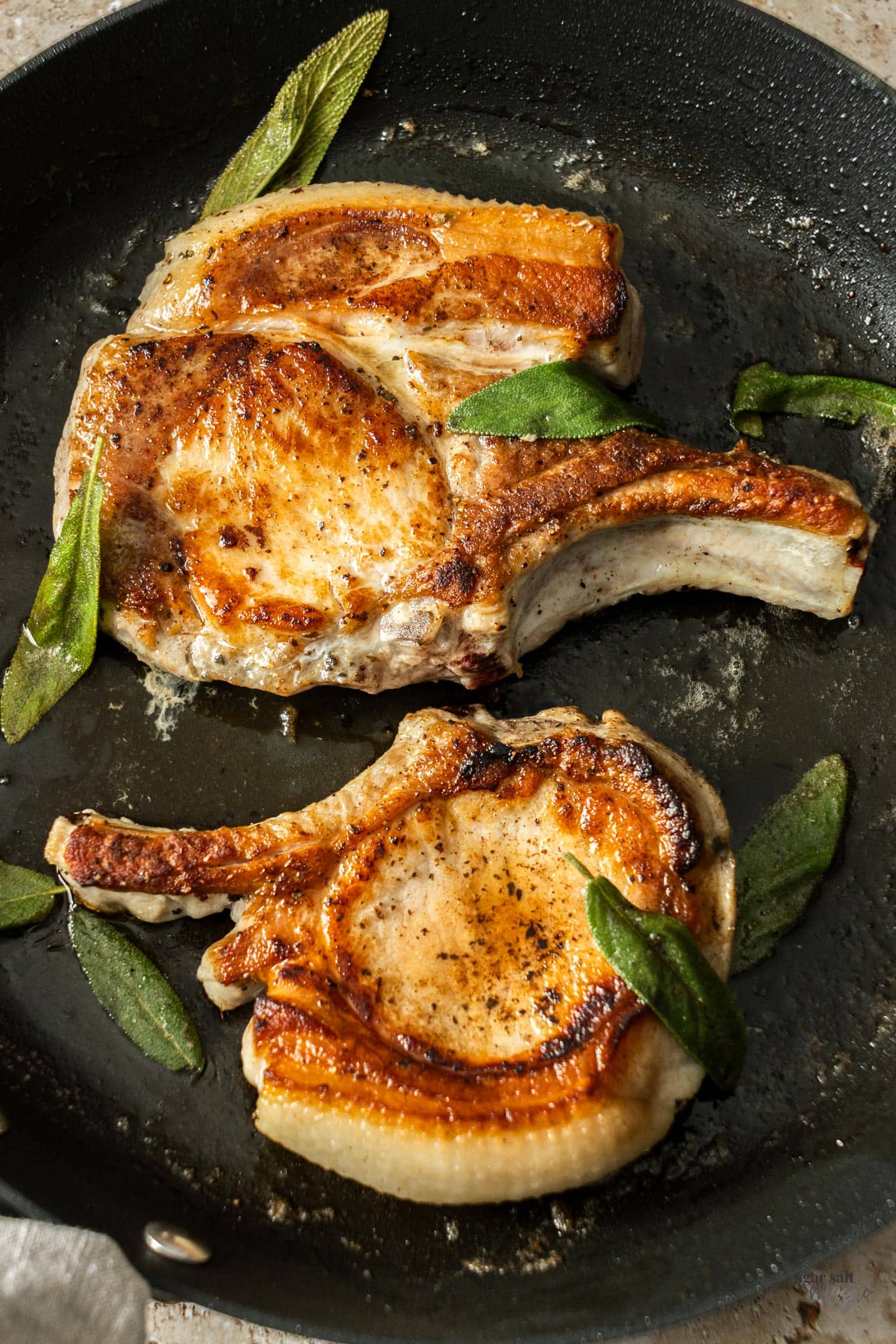
Never Miss a Recipe!
Get the latest recipes straight to your inbox!
What is a brine?
Since I worked out how to brine pork chops, I’ve never cooked them without it. A brine is essentially a salt-water solution that you submerge meat into. This simple kitchen hack infuses moisture and flavour into the meat and actually tenderises the meat too.
You may have heard of dry brining. It’s not technically brining as that requires water, but dry brining is a way to season meat and can be more correctly thought of as a dry rub or cure.
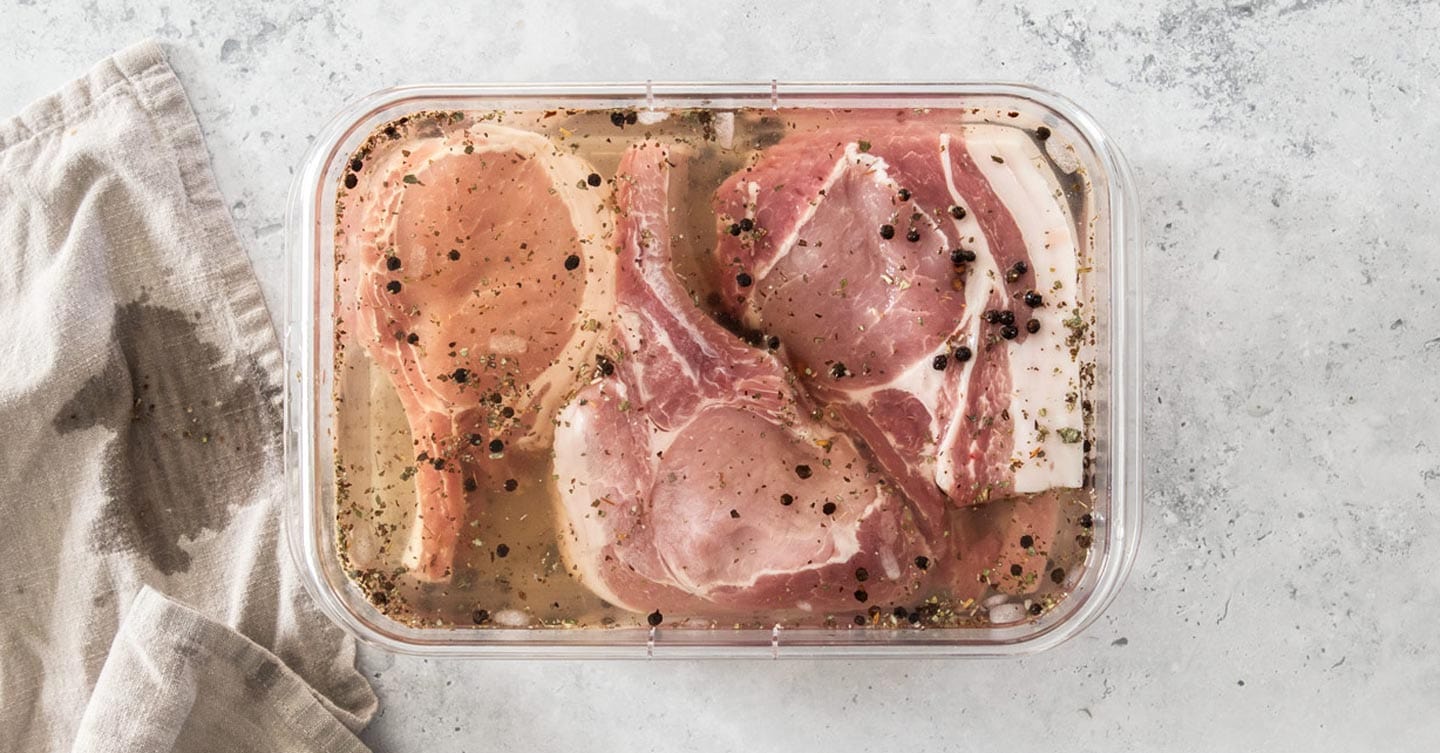
Why you should brine your meat
- The meat absorbs liquid: As the meat sits in the brine, the water is drawn into the meat. While some moisture is lost during the cooking process, having added more, you are guaranteed juicy perfection.
- It seasons the meat from within: As the meat soaks and the water is absorbed, the seasoning in that water is absorbed along with it meaning your meat is seasoned from the inside out. It creates a much more flavourful cut of meat than just seasoning the outside prior to cooking.
- It tenderises the meat: By denaturing the meat proteins – scientific speak for the way the salt disrupts the natural character of the proteins – it essentially unravels the proteins so they aren’t so tight. This is all to say, it’s a one way ticket to a tender cut of meat. The longer you soak, the more tender it becomes.
What is brine made of?
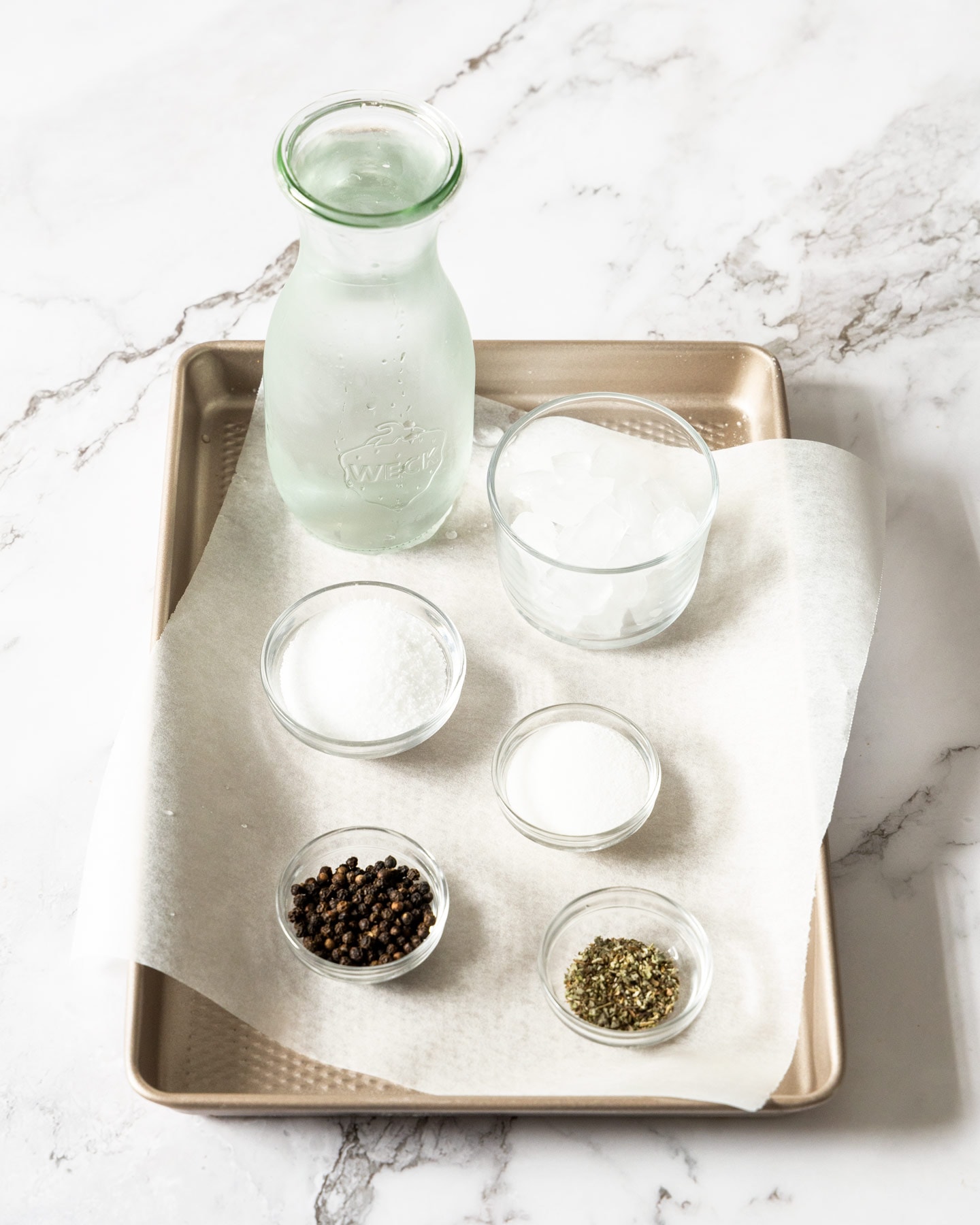
At it’s very simplest, a brine is salt and water. The salt seasons and tenderises and the water adds extra moisture. However, a brine benefits from other seasonings too like pepper and herbs. Sugar is used to add flavour and also to assist in browning.
The classic ratio is ¼ cup of salt to 4 cups of water. I use slightly less salt in my brine – using ¼ cup to what equates to about 4 ⅔ cups of water after the ice cubes thaw – and I find it results in perfect seasoning and tenderising.
The type of salt matters too. Cooking salt or kosher salt are perfect – they have a coarser grain than fine sea salt and table salt so, if you were to add the same amount of table salt instead, the brine would end up much saltier.
How long to brine pork chops
There is a lot of discussion over how long to bring pork chops perfectly, or any meat for that matter.
You can brine for as little as 1 hour per pound or half kilo. This timing is based on the weight of one piece, so even if you have 4 pork chops of around ½ lb or 250g each, you only need to brine for 30 minutes to get a great result.
Of course, the longer the meat sits in the brine, the longer those proteins are being transformed and the meat is becoming softer too. Many suggest brining for more than 4 hours will result in an almost mushy texture and be too salty. I don’t find that at all. Since I use slightly less salt in my brine than some and decided to do my own testing.
For my test I used pork chops, on the bone, nearly 1 inch thick. The very first ones I brined, I accidentally left in the brine for 16 hours. They were fantastic and the meat was not mushy in the slightest but it was incredibly tender.
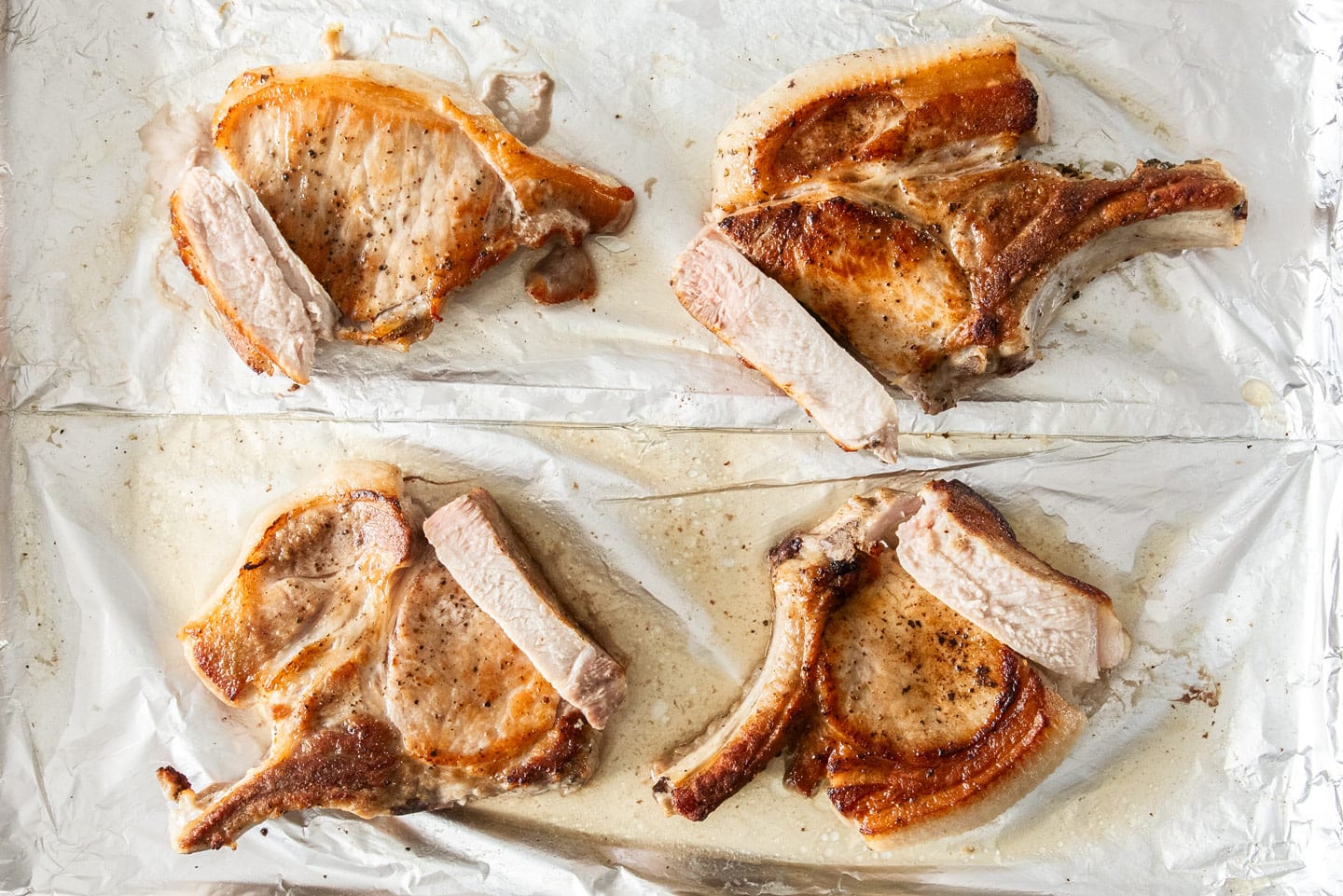
The 4 pork chops shown above were brined for different lengths of time: 2 hours (top left), 4 hours (bottom left), 8 hours (top right) and 12 hours (bottom right). My favourites were the ones brined for 4 and 8 hours. On all 4 test pieces, the meat was lovely and tender, juicy and the flavour was phenomenal but those 4 and 8 hour ones were just that bit more enjoyable. None of them were mushy or too soft.
I suggest playing around with brining and find your own perfect timing. If you want to get it done quickly for dinner after work, then try the 30 minute method or if you have a little more time on the weekend, try a longer one. Anything more than 30 minutes and less than 12 hours is going to give you a great result.
How to make pork brine (step-by-step)
Brine for pork chops is so quick and easy and can be made ahead of time, so you can make up a batch any time and have it sit in the fridge unused for up to 4 days.
Jump to the recipe for full ingredients and instructions.
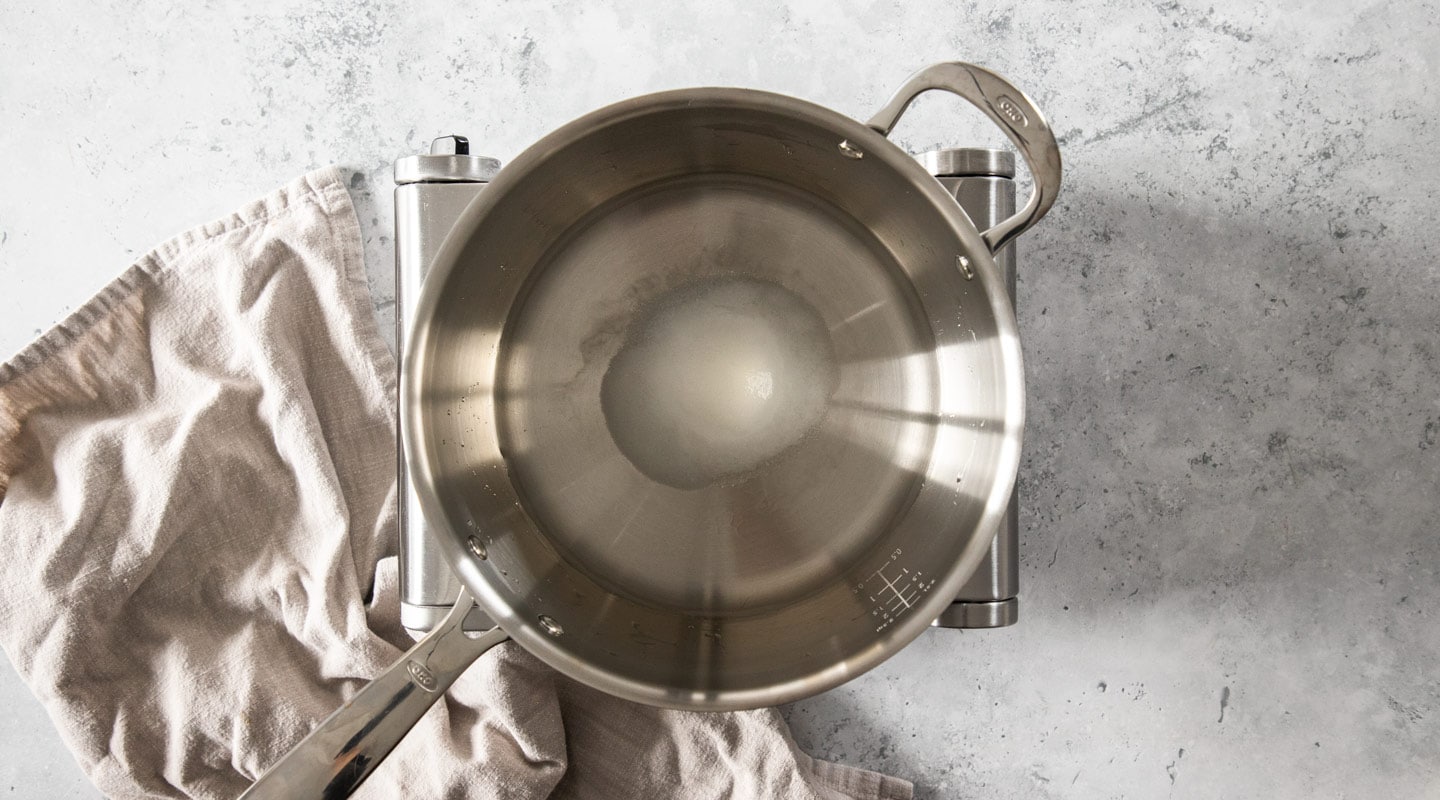
- Water, salt, sugar: Place water into a saucepan over high heat and stir until the salt and sugar fully dissolve.
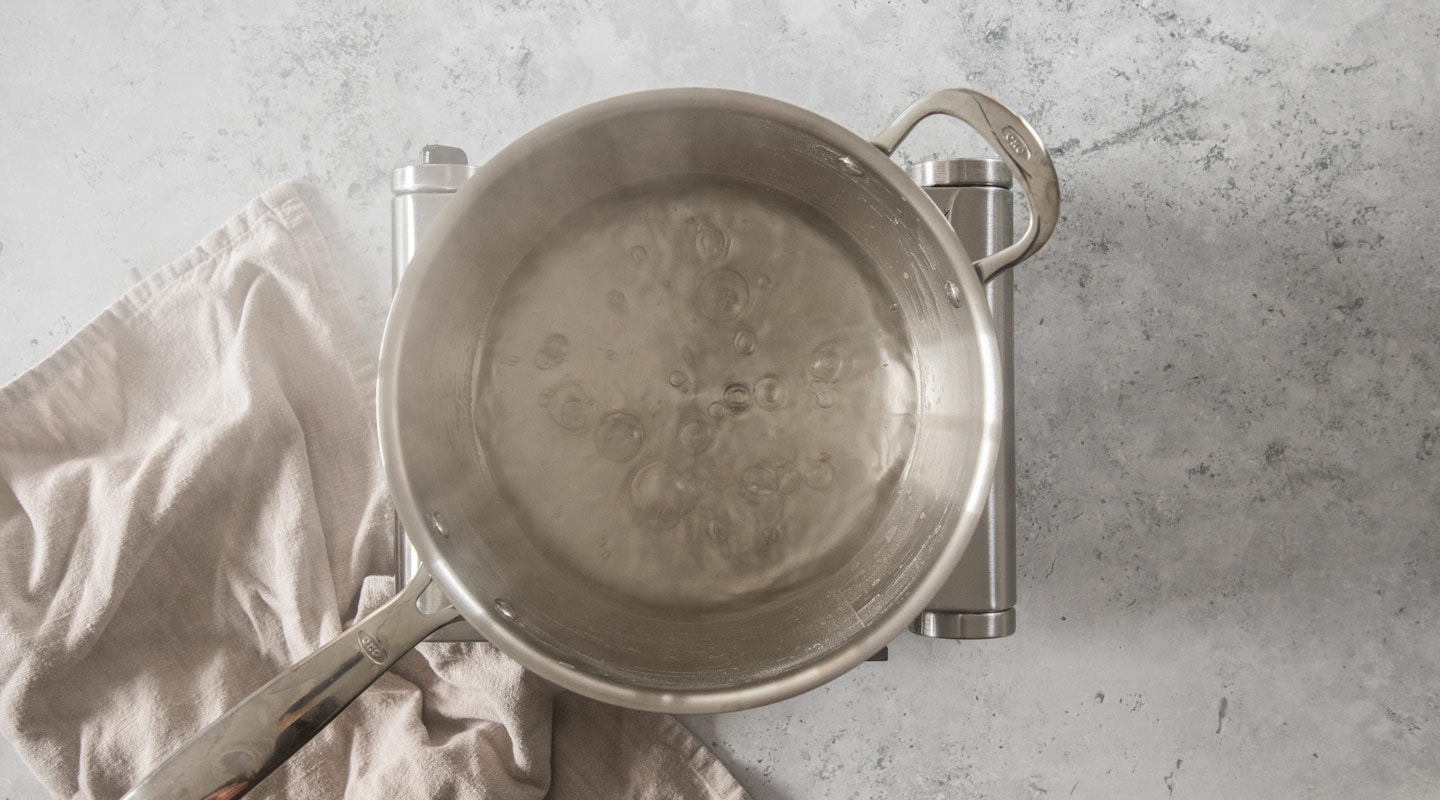
- Boil: Bring the mixture to a boil then remove from the heat.
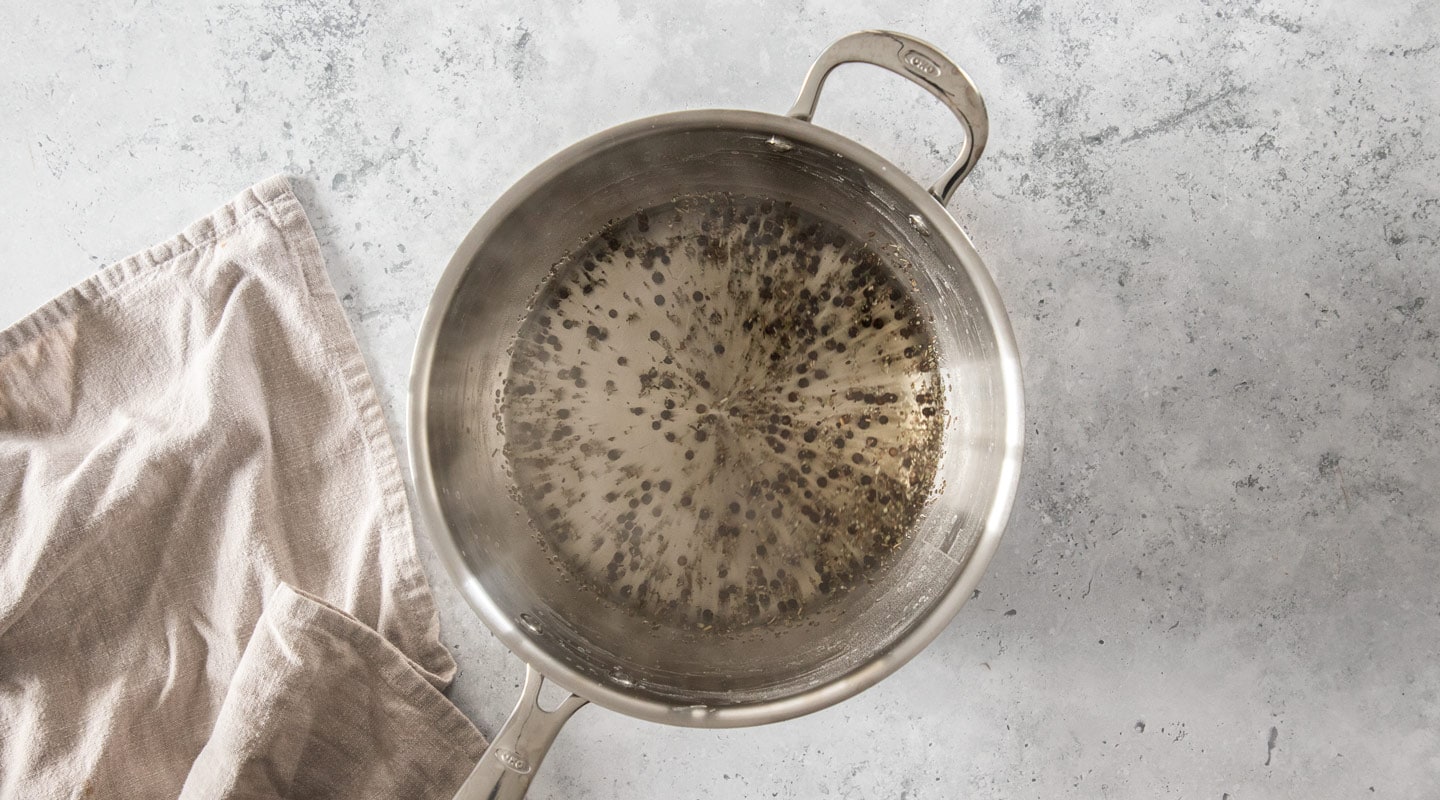
- Flavourings: Add the pepper and dried sage and let it steep for 1 minute. You can also add other dried herbs, fresh herbs, spices or cloves of garlic too.
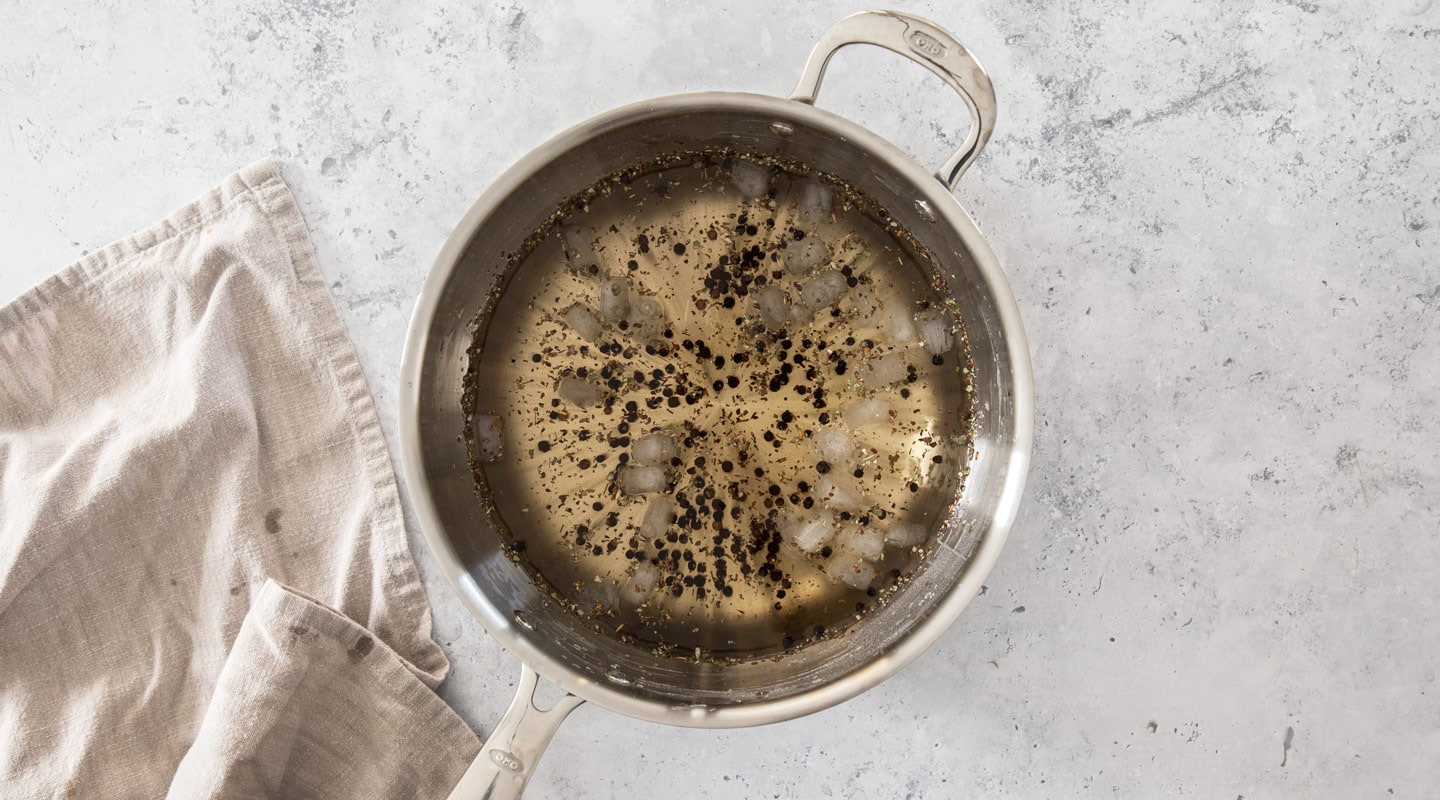
- Cool: Add the cold water and ice.
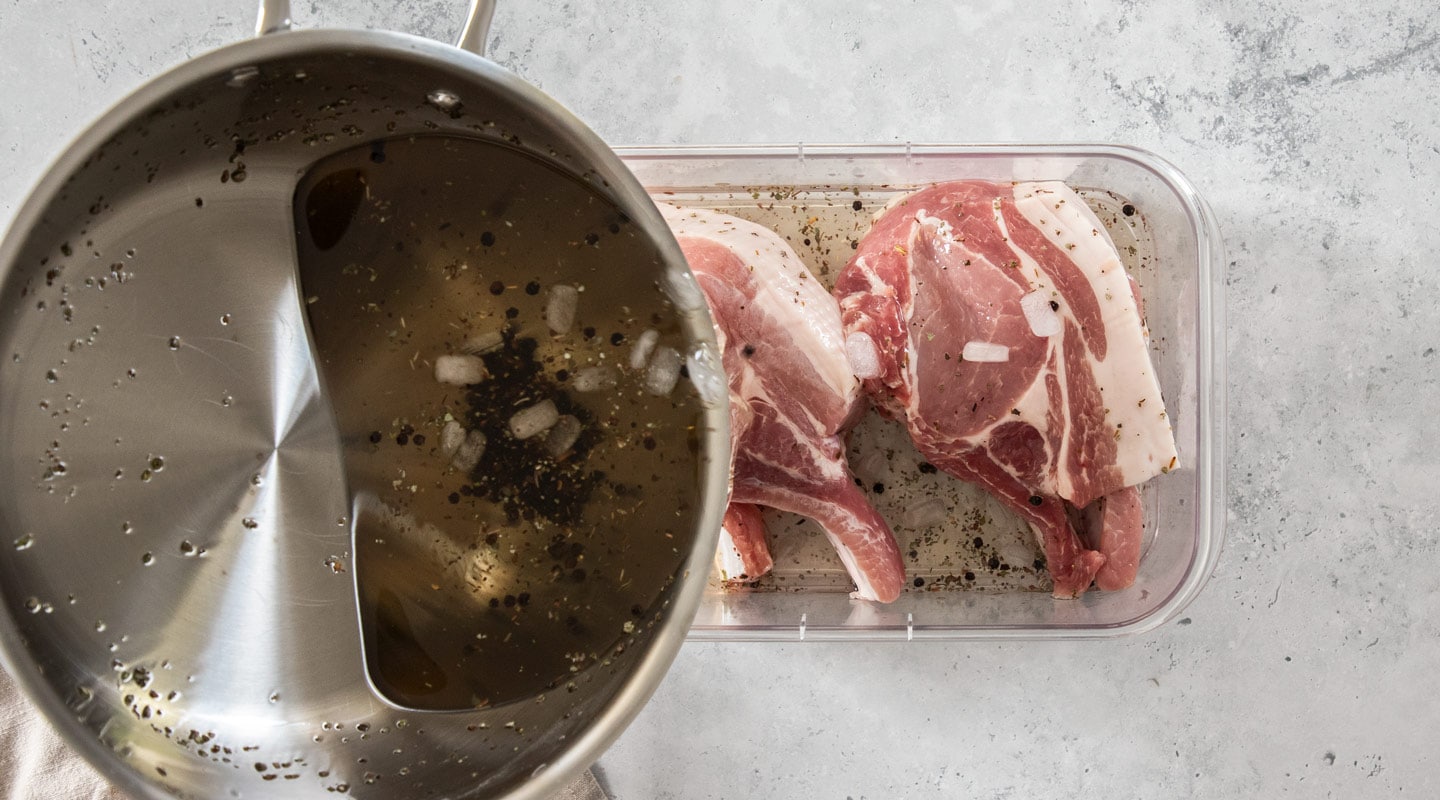
- Brine the pork: As long as the brine is cool to the touch, which it should be if you’ve used cold water and the right quantities, pour it over the pork in either a large ziplock bag or dish which is just large enough to fit everything. Don’t use an overly large dish or the pork chops may not be covered.
How to cook brined pork chops
- Rinse and dry: After brining your pork chops you need to rinse the meat off and pat it dry with paper towel. If you don’t rinse the meat, it may end up tasting too salty. Don’t worry, you aren’t washing all the seasoning away since the brine has seasoned the inside too.
- Sear then bake: I love to sear my brined pork chops over high heat until nice and golden brown, then transfer to the oven at 220C / 425F to finish cooking for 8-12 minutes.
Tips and tricks
- Use kosher salt or cooking salt: Not all salts are created equal. Kosher salt or cooking salt are the best ones to use for this brine. Table salt has a slightly finer grain than these two which means you’ll end up with more salt even if you still use ¼ cup. If you use table salt, cut the quantity down to 2 tablespoons (or 3 US tablespoons). If using Kosher salt, keep in mind Diamond Crystal kosher salt has much less sodium so a less salty flavour than other types. Regular kosher salt is fine to use.
- Use a suitable container: The meat must be fully submerged so make sure your container is the right size to just fit the pork chops and the brine without too much space leftover.
- Sugar: You can use brown sugar or even honey or maple syrup in place of the white sugar. It is used to balance the flavours and assist with browning later. It doesn’t affect the texture of the meat.
- Take meat out of the fridge and brine ½ hour before cooking to help the meat cook more evenly.
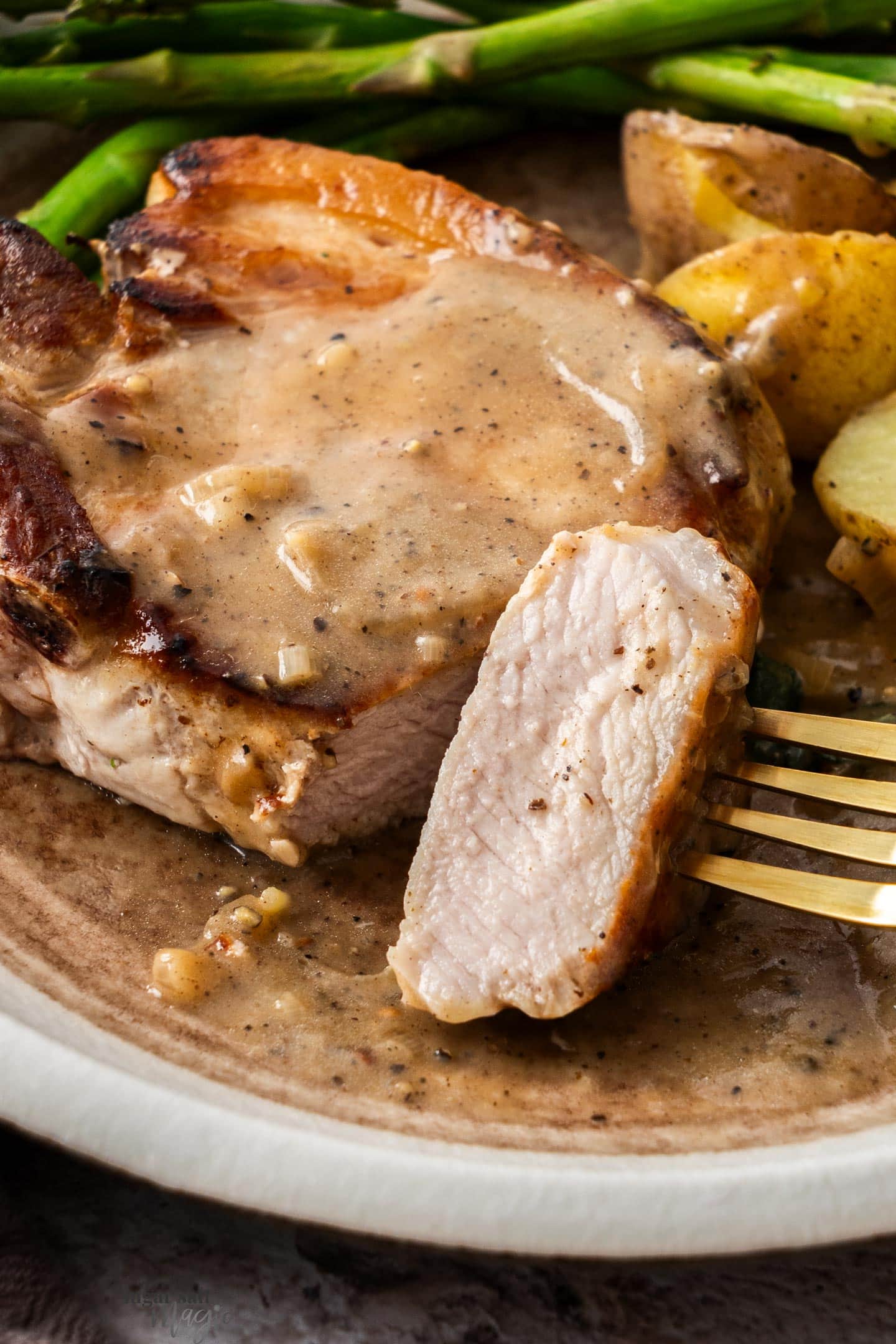
Brining Safely
Brining is a very safe method of seasoning and tenderising meat so long as you stick to these golden rules.
- Keep it in the fridge: Always store your meat in brine in the fridge until at least 30 minute prior to cooking to prevent salmonella developing.
- Never reuse brining solution: The brining liquid is good for 1 batch of meat only then discard it. Don’t reuse for another batch.
- Make sure the brine is cool before adding the meat or you risk slightly increasing the meat temperature to one suitable for salmonella.
- Use glass, stainless steel or food-grade plastic to store your brining meat.
Variations / Substitutions
- Meats: You don’t just have to use this brine for pork chops. It’s suitable for brining other meats or other cuts of pork as well. You can brine anything from chicken drumsticks to a whole turkey to a beef roast. I have used it on chicken breasts with fantastic results. I love using thick bone-in pork chops like those shown here. Pork tenderloin also works really well.
- Dried herbs: Add any herbs you like and let them steep in the hot liquid before adding the cold water. You can add around a tablespoon of herbs to this quantity of brine for a great flavour. Add dried thyme, oregano, rosemary, fennel seeds, chilli flakes, bay leaves, juniper berries.
- Fresh ingredients: You can also add fresh ingredients like garlic cloves (bruise them first) sliced onion, fresh herbs like thyme sprigs, rosemary or sage leaves. Citrus peel like lemon or orange.
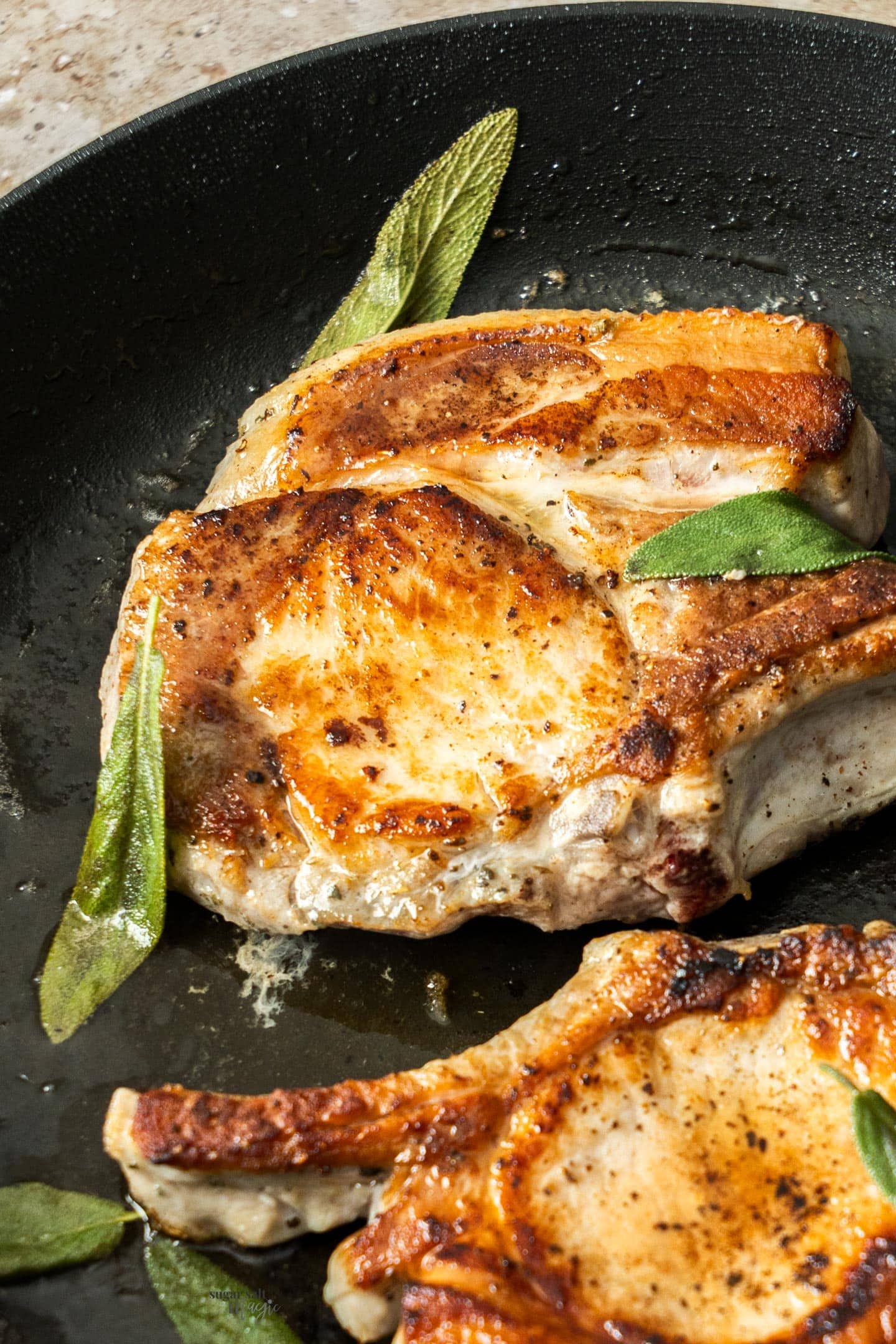
FAQs
A minimum of 30 minutes per ½ lb / 250g based on the size of any single piece. So 4 pieces of pork at 250g will still only require 30 minutes. If it was one single piece at 1lb / 500g, you would brine for a minimum of 1 hour. You can brine thick pork chops for up to 12 hours.
A basic ratio of salt to water is ¼ cup kosher salt to 4 cups of water is a very common brine.
Yes. I have brined pork chops with great results for 16 hours but you certainly don’t want to go beyond that. Most brining recipes will suggest no longer than 12 hours.
No. Brining pork chops for longer than 16 hours may result in a mushy, unappetising texture and a far too salty flavour.
Yes, always rinse pork chops after brining and pat dry with paper towel before cooking.
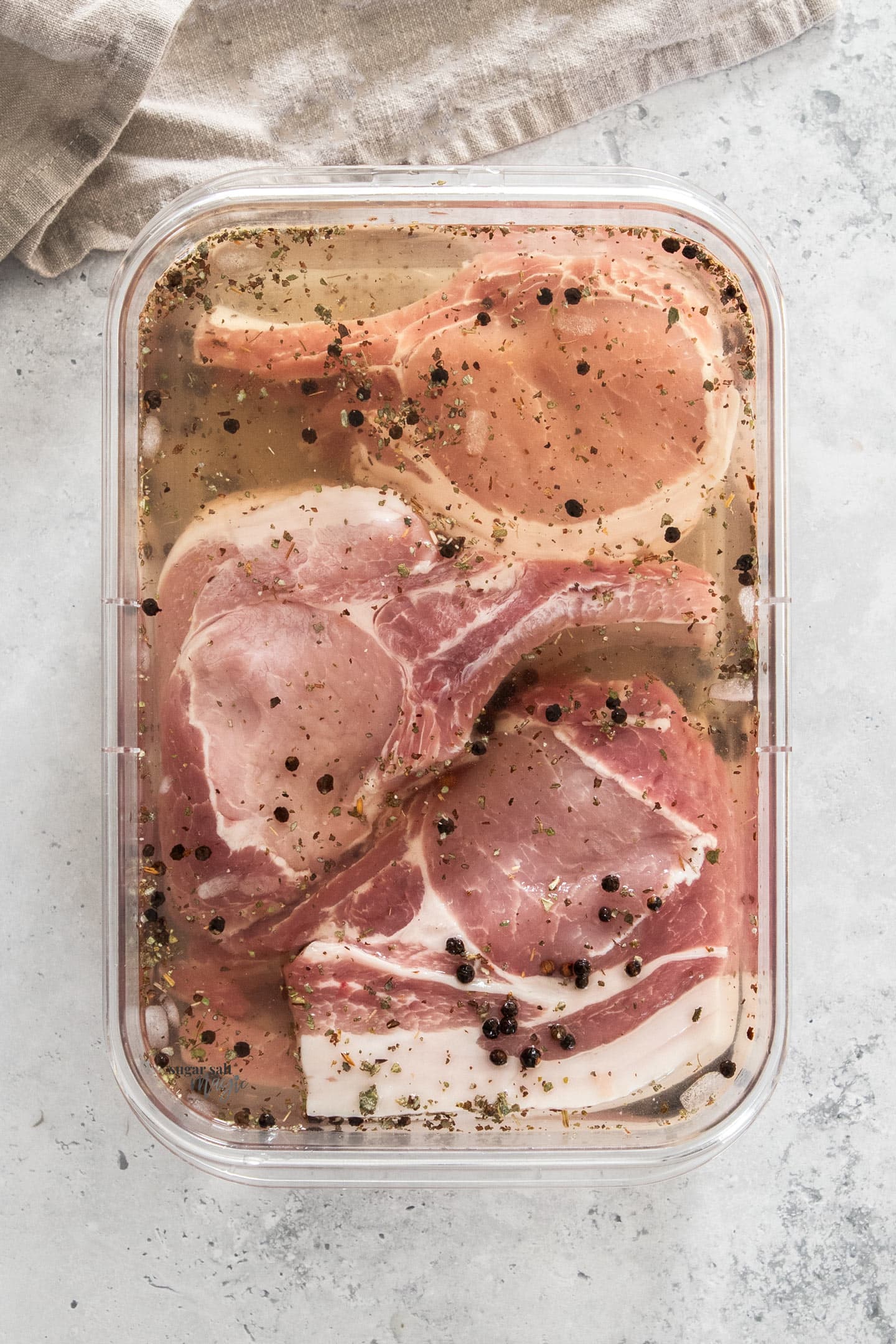
Try these pork recipes
Did you try this pork chop brine recipe?
Leaving a rating and comment below the recipe is so helpful!
Hungry for more? Subscribe to the newsletter for free recipes straight to your inbox. Also, follow along on Facebook, Pinterest and Instagram.
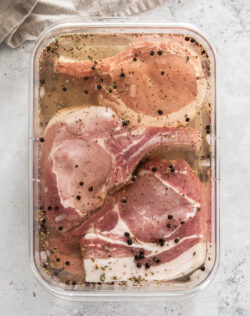
Ingredients
- 4 cups water (3 cups of it cold)
- ¾ cup ice cubes
- ¼ cup cooking salt / kosher salt
- 1 tablespoon sugar
- 1 tablespoon whole black peppercorns
- 2 teaspoons dried sage
For best results, always weigh ingredients where a weight is provided
Equipment
- Saucepan
- Large glass dish with lid or zip lock bag
Instructions
- Place 1 cup of water into a small saucepan over high heat. Add the salt and sugar, swirling often to dissolve it and bring it to a boil.
- Turn the heat off and add the peppercorns and sage and let it steep for 1-2 minutes.
- Add the remaining 3 cups of cold water and the ice cubes and stir to combine.
- Place your pork chops into a dish or container with just enough room for the both the meat and the brine. Pour the brine over the top and cover.
- Chill for 1 or up to 12 hours.
- Rinse the meat under running water and dry with paper towel. Cook your preferred way.
- Please take a moment to leave a comment & rating. It's appreciated and so helpful.
Notes
- Tablespoons: I use a standard Australian 20ml tablespoon (equal to 4 teaspoons). Check yours before measuring.
- Quantity suitable for 4 pork chops, 1 inch thick or less. Can also be used for other meats like chicken, turkey and beef.
- Get creative with the herbs. You can add fresh herbs or dried and try a combination to see what you like most.
- Add a couple of peeled cloves of garlic for a different flavour. You can leave them whole, or slice them up.
- Try adding some strips of lemon peel or orange peel.
This post may contain affiliate links that earn me a small commission for my referral, at no extra cost to you. Thank you for supporting Sugar Salt Magic.

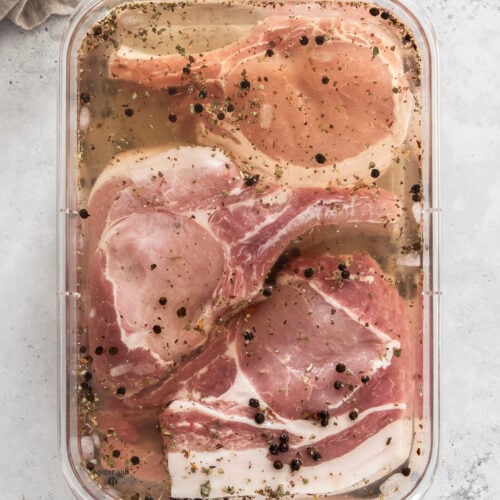
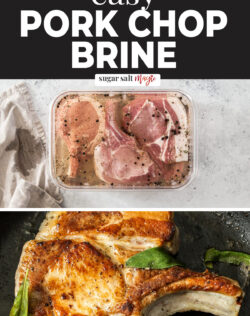

6 Comments on “Brine for Pork Chops”
This is a game changer! Thanks.
I totally agree. I always start my pork with brine now. So happy you love it too.
Awesome tasty
It really is isn’t it. Thanks so much for dropping back to review, Nancy.
Very thorough and easy to understand. Good job
So happy it’s helpful, Ted.